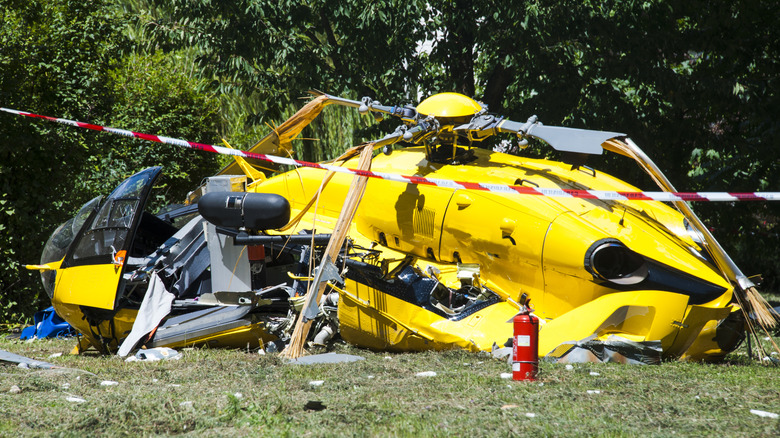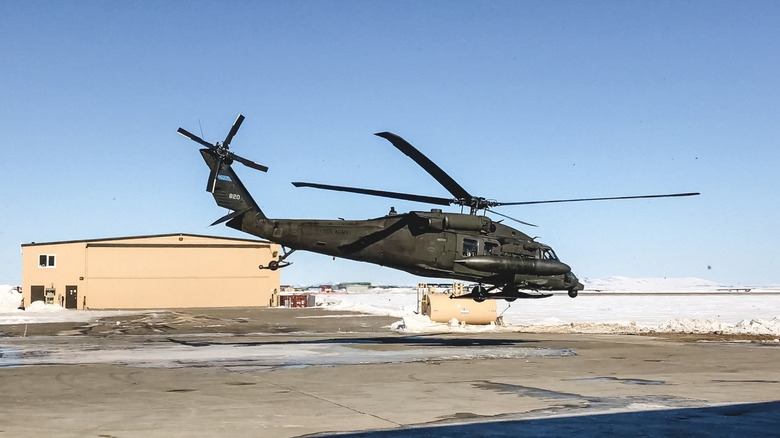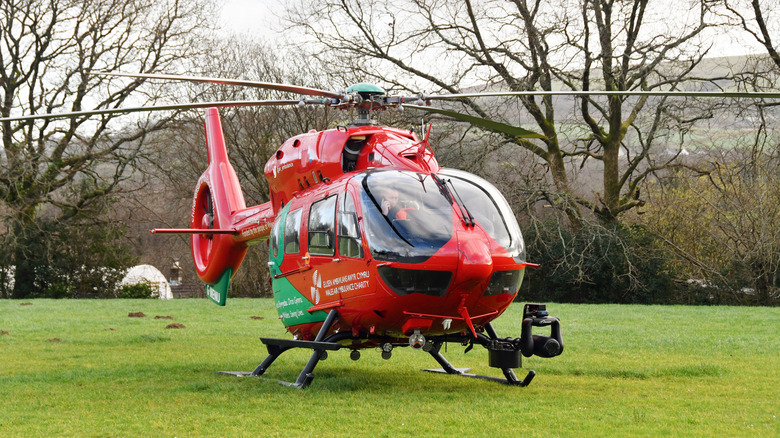How 'Ground Resonance' Can Completely Destroy A Helicopter In Seconds
Aviation is an art form, albeit a very sophisticated one, that can be high-risk, high-reward. Take, for example, modern-age helicopters. They have existed in toy form for nearly half a millennium, but it wasn't until the 19th century that we got the first working precursor courtesy of Sir George Cayley. As the aviation technology matured, more manufacturers started making helicopters. The systems got more sophisticated, which inevitably also upped the number of risk variables. One of those risks is ground resonance, which arises from rotor blade issues and can tear a helicopter to bits in less than a minute.
As you can see in the video above, the helicopter appears ready for takeoff, but soon, it starts vibrating haphazardly, culminating in a catastrophic breakdown. At first glance, it's hard to decipher what exactly went awry. According to a research paper published in the International Journal of Non-Linear Mechanics, ground resonance is a "destructive mechanical instability" that happens due to coupling between the movement of the rotor blades and the motion of the main body linked to the landing gear.
It usually happens when the helicopter is still in contact with the ground, and it's characterized by severe instability that can end in the "total destruction" of a helicopter. It can, however, happen during the landing phase, too. The problem was first observed in gyrocopters or gyroplanes, but was later recorded in rotary-wing vehicles as well.
Why does it happen?
Robert Coleman and Arnold Feingold, while working at the Langley Aeronautical Laboratory, published what is considered an influential technical assessment of helicopter dynamics, rotor mechanical instability, and the resulting oscillations. According to them, the phenomenon of violent instability in helicopters was first observed during World War II. The reason it's called ground resonance is that the process was observed when the helicopter was on the ground or close to a landing surface.
Technically, it came to be known as "self-excited instability of hinged rotor blades." As the name makes it abundantly clear, it originates from unexpected movement associated with the rotor blades, which disturbs the motion symmetry and causes the rotor to tilt and wobble.
These out-of-phase angular motions interact with the fuselage parts (typically the landing gear), which leads to wild oscillations of the entire structure due to vibration. "Deflection of the rotor hub may be due either to the bending of a flexible pylon or to a rocking of the rotor craft upon its landing gear," the authors note in the research paper, which investigated the phenomenon in double and triple-blade helicopters.
Simply put, the inertia generated by the rotor blades on a helicopter goes out of phase and leads to a lagging motion, which interferes destructively with the motion originating from the landing gear and produces violent vibrations. Subsequent research, one paper about which was published in The Aeronautical Journal (PDF), notes that there are actually six regions of instability associated with ground resonance, instead of a single plane.
How to avoid it?
According to a technical paper released by the Defense Technical Information Center, which operates under the aegis of the U.S. Department of Defense, the occurrence of ground resonance can be curbed by a few modifications. The paper argues that by careful understanding and calibration of the undercarriage's damping and stiffness, and adjustments to the in-plane damping of the rotor blades, the instability issues leading to ground resonance can be avoided.
Interestingly, the problem is considered so serious that all the helicopters that enter the defense services are made to pass the ground resonance test. Interestingly, the tests are also conducted in abnormal conditions, such as a sloping surface, a flat tire or strut on one of the sides, scenarios where one of the dampers is not working, and icy surfaces.
Typically, ground resonance is tackled by installing lag dampers at the base of the rotor, which can either be hydraulic or elastic. Over the years, experts have also experimented with magnetic and piezoelectric dampers, as per a paper published in the Journal of Vibration and Control.
What if it happens when there's people sitting in the pilot and passenger cabins? The pilot must try to take off, if possible. As soon as ground contact is lost, the intensity of vibrations decreases, and the aircraft can stabilize. Another strategy is to shut down the engine or reduce the rotational speed of the blades in order to slow down the rotor, though neither method is foolproof.


